On the sum total of four hours’ sleep, we ventured back from the Wave over to Jonny Hot’s house, encountered humility and hilarity in equal measures by him and his parents, before setting off on another strenuous hike. Was there no end to this boy’s bottomless pit of energy? Intent on breaking me, you can sleep when you’re dead, was the long and short of it. An intriguing little grotto—home to a series of remarkably distinct petroglyphs awaited us high in the hills near Kanab.
No less than a five-mile round stomp, we scaled and scrambled over 300-metres to an outcrop of Navajo sandstone overlooking the Vermillion Cliffs and Kaibab Plateau. Clawing one’s way through the pinstriped landscape of steep, uneven terrain was required to ascend upon a two-metre sandstone ledge. Yet another remote and concealed gem known as the Mansard site, which when Jonny Hot enquired about to the BLM (Bureau Land Management), got a flat denial in their response as to its existence. Doubtless testament to the damage done by hordes of disrespecting folk only a few decades back. Taking several years, Jonny Hot chanced upon the petroglyphs one day—to our stellar good fortune. Nice work, Jonny boy.
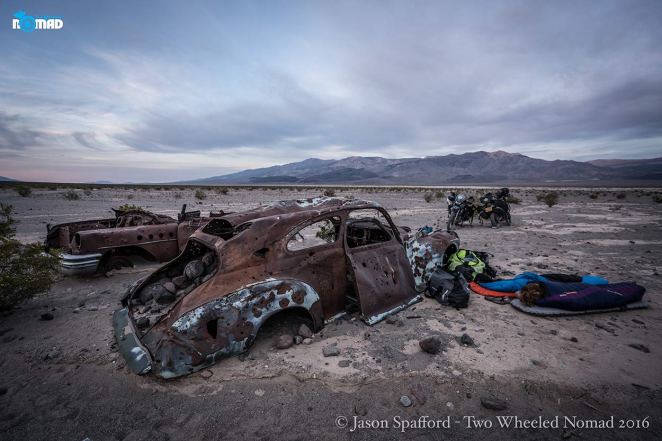
Laying down tired butts at Panamint Butte
When the Navajo Sandstone loses its signature ochre, peachy orange and reddish brown stripes, myriad round, ironized stones often clutter the ground. The marbles are concretions—sandstone balls bound in a hard shell of iron oxide minerals. Referred to as “moqui balls”, thousands of the milk chocolate-coloured rocks are scattered across Arizona, and Utah as it happens.
As I studied the 45-degree rock face at Mansard, it came alive with ancient depictions of tribal people, animals and symbols. Men using their bow and arrows, turkey’s feet, snakes and a line of bear paws to name but a few. Agreeing with Jonny Hot, a two-duct channel running from the top of the ledge to the bottom looked as though it could have been a slide for children to play on, while the adults tended to daily business. Struck with a sense of awe, reverence and question, I was looking at the whispered secrets from—according to Jonny Hot’s research—700 to 800 years ago.
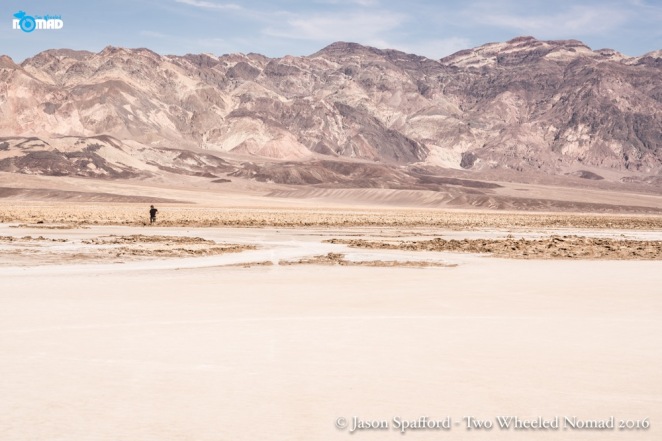
Hot, dry desert for 3,000 square miles
Some archeologists advocate that petroglyphs were not considered art to those who put them there, but rather communication, because of the use of symbols. Makes sense. While rock art exists all over the United States, the Southwest is a treasure trove for it. Commonly found in sheltered spots, on rock faces, and usually far away from populated areas at the time. And incredibly, precariously high up at great heights, achieved by clambering up at one’s peril: grasping tiny hand holds in the rock to unfathomable points and places.
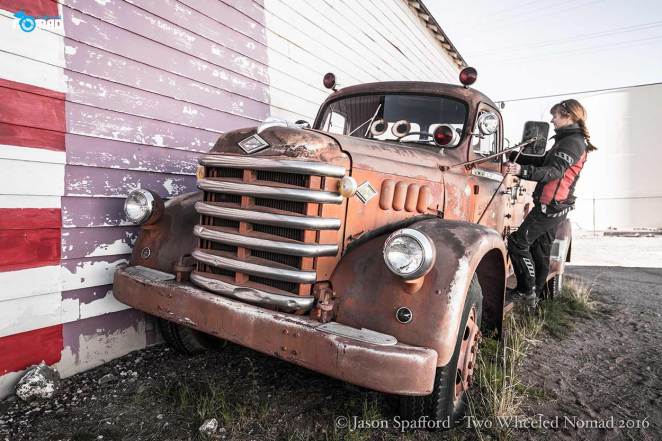
Old trucks are ten a rusting penny on Route 66
Interestingly, two distinctions separate rock art. A “petroglyph” is a picture or symbol pecked into the rock’s surface, where I understand the majority of rock art found in the Southwest is of this variety. Petroglyphs have stood the test of time well since indentations can better endure the elements. Probably explaining why rock art is often found clustered, with groups found together. A “pictograph” on the other hand is a painted symbol. Different sites can offer a surprising variety of painted colours—made by mixing different natural minerals and plants.
I wondered if the pictures and symbols were the mark of a certain Indian tribe. Jonny Hot suggested they may well have originated from the Anasazi tribe. While some symbols were common to certain tribes, particular ones, I’ve read, were meant to warn others, scare even. Invaluable clues to the life of the indigenous people long, long ago.
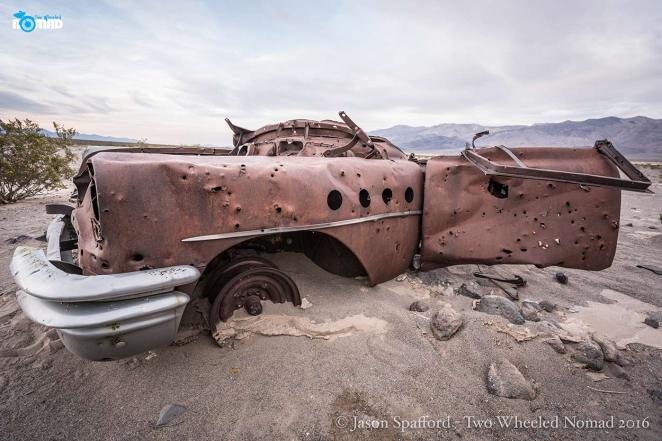
Could it be Thelma and Louise’s old Cadillac?
Post an endearing chat over the sweetest hot chocolate with Jonny Hot and his spirited parents, owners of Black Feather Tipi—accredited Utah’s number one B&B, I lay in bitumen-black darkness, amid the glow of streetlamps—the dull shine of silent cars and the still of the urban night punctuated only by the distant screech of two yappy type dogs. Tired, I sank like a stone into sleep.
Aside from an eye-popping jumble of giant boulders at a place called Mountain Dwellers, endless straight roads ruling their way through a dry, rocky landscape—perfectly aligned with my classic envisionment of the Southwest. The back-to-back week of burning the candle at both ends resulted in the lapse of two days before a full battery of energy to come back to me. Goodness, I don’t bounce back like I used to!
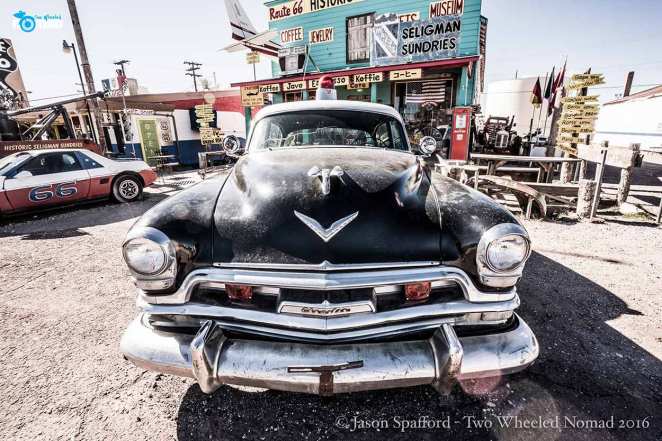
The rad old Route 66
For sure, I read all the amusing Burma Shave advertisements from decades past—popping up on the roadside every few hundred yards, in between several pit stops on the Mother Road that is Route 66. Scanning the sanguine slogans: “If you want a hearty squeeze, get our female anti-freeze”, “Pedro walked back home, by golly his bristly chin was hot-to-Molly” and the finale for me—“Don’t lose your head to gain a minute, you need your head your brains are in it”, kept me riding miles of smiles.
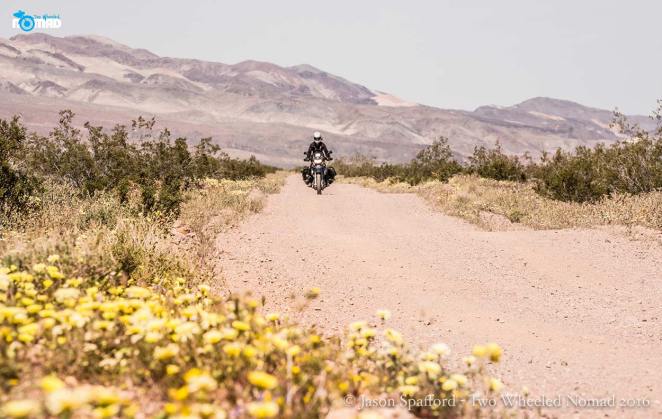
The surreal experience of DV’s super-bloom
Nipping into Nevada, Las Vegas saw the start of things to come: feasting until I was full as a tick on a hound dog. Accompanying our new crew—a four man-strong seasoned expedition team from Overland Journal and Hema Maps, an Australian company, the irony of losing our whereabouts inside the park’s 3,000 square miles wasn’t altogether lost on me. Still, Jason and I would be riding alongside two fully featured and breathtakingly equipped 4x4s. Despite the vultures searching for carrion overhead, plunging into Death Valley alongside what felt like our personal support team for five days, gave me the confidence needed to get out there and kill it.

Glad there are a couple of chase trucks with me in DV
Venturing into the national park from the south—the hottest, driest and lowest land in North America, which straddles Nevada and California east of the Sierra Nevada Mountains—we wended our way towards Shoshone, a town in Inyo County. Impassable washes immediately prevented us from taking the faster route deeper into the interior, where diverting onto an off road route had ill-prepared me for just how soon I would need to jolt my muscle memory.
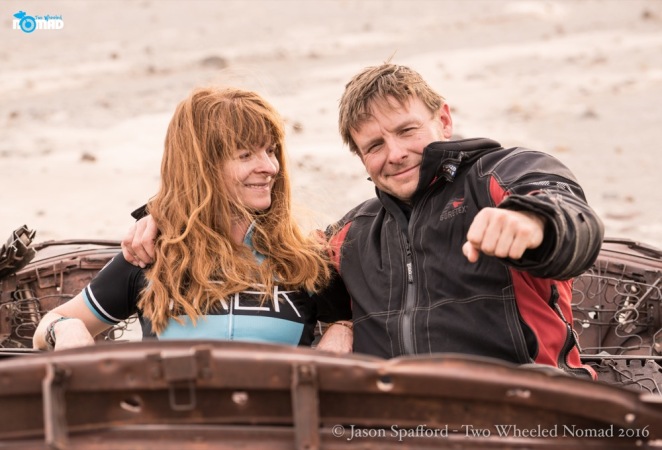
“Hold on tight, sugar lips!”
“Please Lisa, just promise me you’ll stay in second gear once we head down this trail and give it the tiniest amount to stay positive when it feels twitchy,” he pleaded. Knowing he was referring to both the gas as much as my temperament didn’t take a lot to unravel. “Basically, you just need to suck it up, I can’t ride your bike for you,” was his pragmatic conclusion. Looking back, I think it’s the reason you never hear the phrase ‘male intuition’.

Two fifths of my solid support team: Rob Boegheim, Hema Maps and Scott Brady, Overland Journal.
Pearl, we’re up! But not you sweetie, you’re going down. While Scott, the expedition leader strongly recommended that we air down, reducing our tyre pressures was something Jason had only paid mind to momentarily. Honestly, he hadn’t wanted to invite a pinch flat caused by the tube getting “pinched” between the tyre and rim, out in the middle of nowhere. Particularly when water is always in limited supply on two wheels. Nor did Jason really believe it would make a significant difference in traction. Mmn, it made the world of difference.
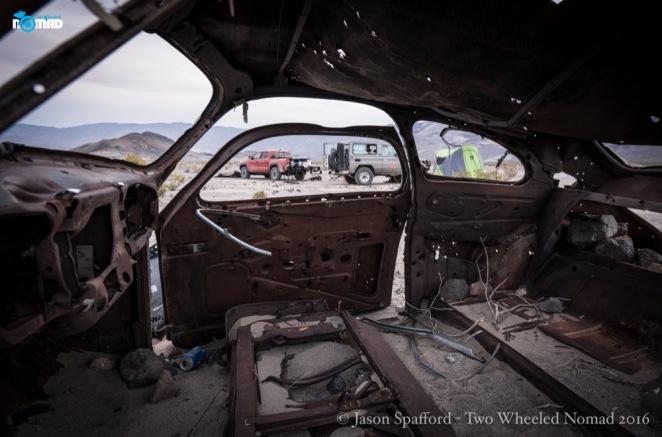
One rusting old car and two breathtaking 4x4s at our camp
After day one of the expedition, I knew categorically, more by feel and sixth sense than by appearance, Pearl imparted to the sandy gravel itself a sense of sureness and a generosity of spirit. She exuded poise as much as purpose that took me in, urging to keep her steady on the twisting trails. She told me just by the touch of her handlebar grips and reassuring body to which my knees assertively squeezed. Despite fishtailing, we weren’t squirming. Instead, the pair of us sewed our way around the hem of a rah-rah skirt of a route through Death Valley, without fraying any nerves.
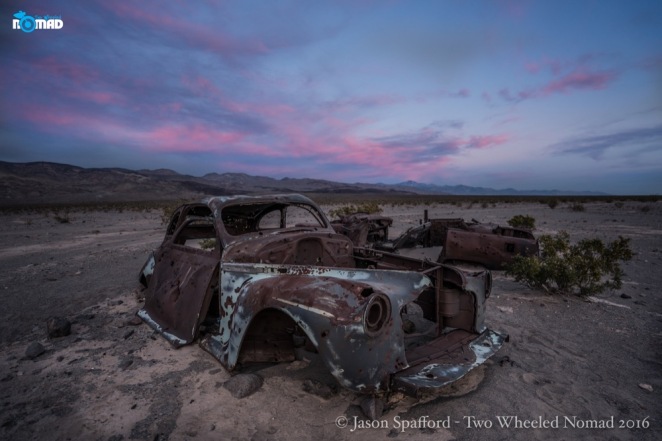
The crazy-cool cars in the desert
If you have been in its presence on two wheels then you know how anything loose commands your respect. Trembling with fatigue or something a lot more human, thank goodness for adrenaline I thought. And Larry, who seamlessly replenished my hydration levels while plying me with calorific energy bars. Nutritiously delicious, if they’re good enough for the prized horses and dogs on his ranch, they’re good enough for me.
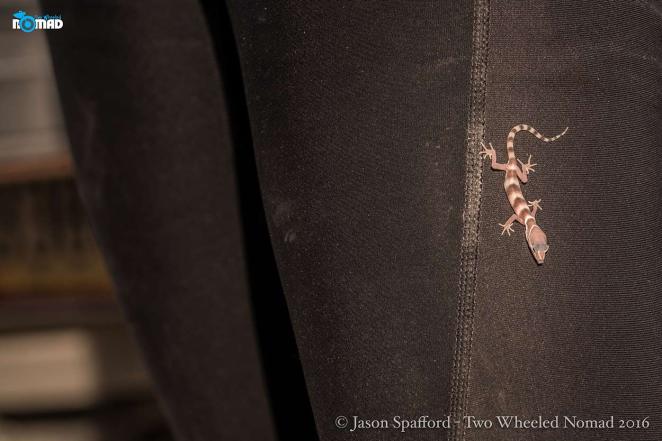
A desert banded gecko warming up on my tights
While the landscape is mostly bereft of plants and its climate severely lacks precipitation, Death Valley still displays incredible biodiversity. Wild burros, red-tailed hawks and bighorn sheep can all be spotted without too much squinting into the distance; there are lizards scurrying all over; myriad birdlife and hundreds of springs and pools magnetizing the wildlife. Not to mention areas home to forests of cottonwoods, willows and Joshua trees. Moreover, when conditions are smack dab perfect, Goldilocks’ ‘just right’ no less, optimal rainfall combined with water from the regular snowmelt, contribute towards a once-in-a-decade super-bloom. Whoa!
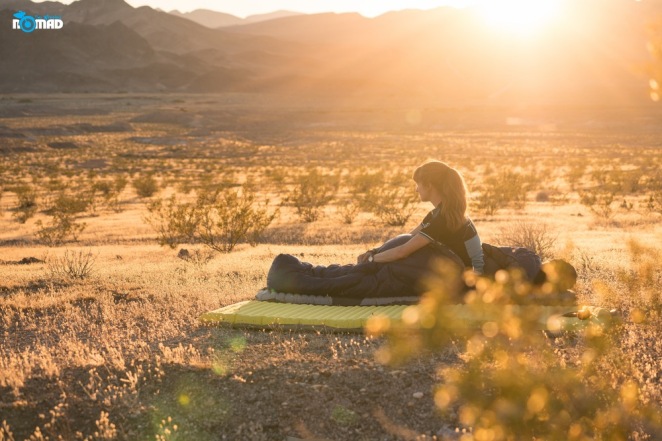
A patina of gold over our first camp, DV
The odds of us witnessing such wonderment when the last one was reported to have occurred 11 years ago by the Los Angeles Times, wasn’t wasted on me. When the earth warms slowly enough to meet the root’s criteria in sprouting from deeply watered soil, coupled with a moist, El Niño weather pattern supplying a lifeline to the wild flowers, Death Valley becomes carpeted in magnificent meadows. Beavertail cacti and Mojave Aster to name a couple magically spring to life. Or so we’d heard.
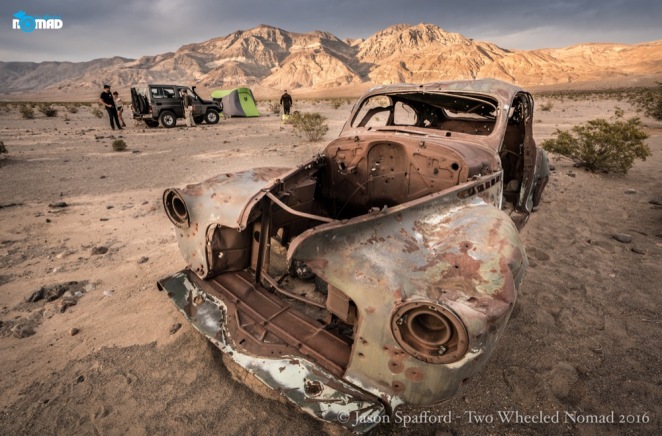
DV will do anything but disappoint
But lo!—our timely arrival saw the tail end of Globemallow, a smattering of pretty reddish orange patches over the ground, far greener than expected. The warm breeze fanned the Desert Gold flowers until they waved like a blanket of gold. Implausibly that afternoon, Death Valley’s sparse backyard looked ripe with nascent possibilities. If the future was a nation, this would be its flag: a blooming meadow amid a landscape of green. The rare floral phenomenon in such a deep, arid desert basin, where the valley’s native plants had somehow managed to explode by the field load, blew my mind to bits in the process.
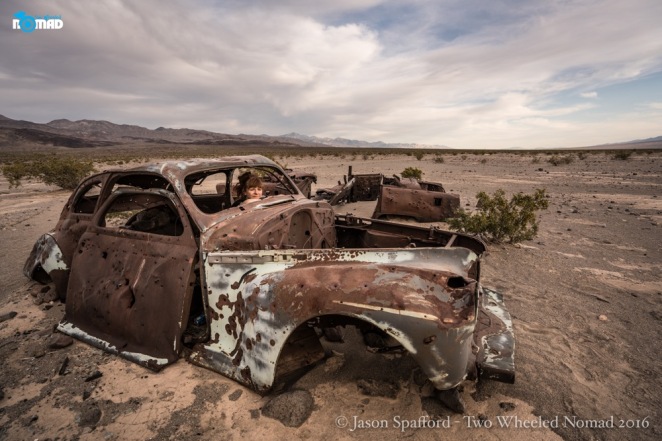
Taking time to survey and absorb my surroundings
Having wove our way past Pahrump and onto Green Water Valley Road via dirt tracks and stony trails, we made camp. Clusters of dust from the desert erupted in a fine spray that pirouetted around us as we sat watching the sun melt into the mountains. Bright and early the following morning saw us back on the bitumen for a brief resupply at Furnace Creek; the spot in possession of the world’s hottest record at 134 degrees (dating back to 1913).
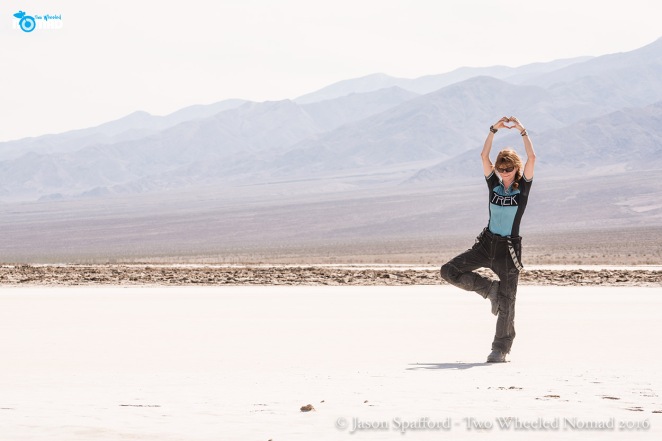
Embracing the heat at +100F
Wheels humming to a song of an off road route, a 4,000 feet climb to more bearable temperatures and a long, straight series of sharp gravelly dips led us to Panamint Butte, on a spur road off Panamint Springs. Its butt battered by the elements and in need of a little polish, an old Cadillac sat adjacent to a roof topped vehicle, just as clapped out and corroded. Even the cars succumb to the Death Valley’s unforgiving nature. In the very dreamy and earthly locale in which I now found myself, I perched on the bonnet of the sandblasted Cadillac before easing myself into its interior filled with rusting springs, jagged edges and sand.
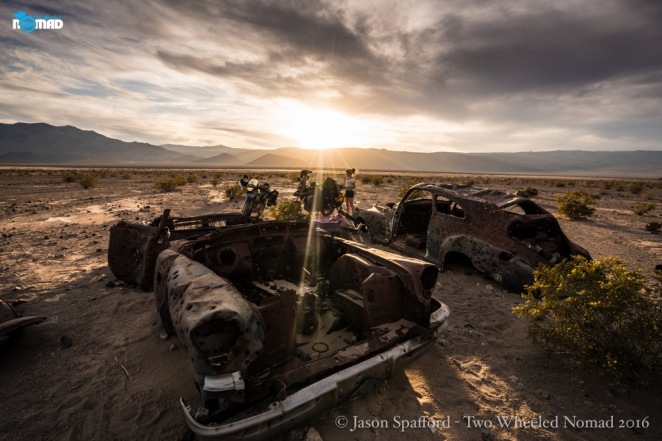
Sun melts in DV are beyond magic
As I lay on the moon-whitened desert floor, I paused to shine my dying beam of flashlight on whatever the dark couldn’t gobble up. In every direction, the sere landscape stretched out featurelessly and farther than the eye could see. Tired, I sank like a stone into sleep.
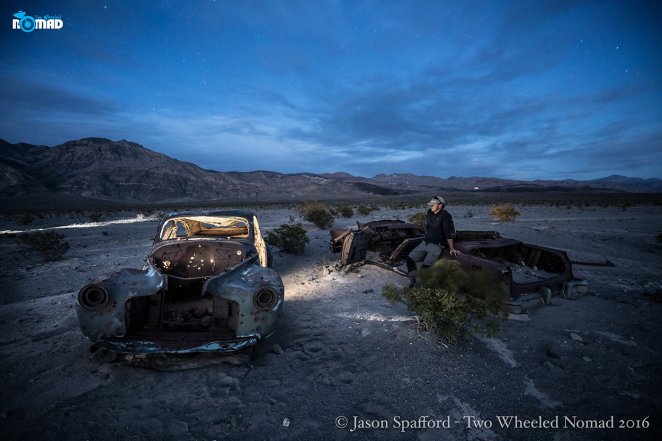
A night time special in DV
The first pale fingers of light pried open my eyes. I awoke to the sight of a pink dawn washing over the cars, our camp, rock and desert. Post a dip into Salt Creek, a mile-long depression in the heart of the valley that supports pupfish, the morning saw us descend upon Badwater Basin. A dry lakebed next to a spring-fed pool of salts from the neighbouring basin, giving rise to the name and leaving the water far from potable.
Standing at the lowest point in North America, we had plummeted 282 feet below sea level. A moment where we just stopped and put down the cameras. Looking up into the snowy mountains standing guard in the day’s searing heat, we absorbed our surroundings—pleased and perspiring in over 100 degrees—and mouthed “Wow”. Perhaps the last place I stood that completely bowled me over.
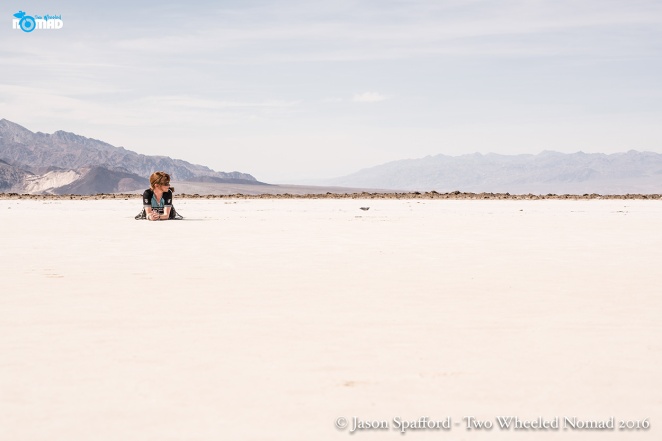
“I’m too hot, not in a good way!”
Heading north, we pressed on past Beatty Junction and Stove Pipe Wells aiming for Death Valley’s hot springs, a closer encounter with the iconic sand dunes and Lippincott Mine Road leading to Racetrack Valley, only to come to an abrupt halt.
Rudely interrupting a wilderness of fun, Jason’s moto took a turn for the worse. The stator’s waning ability to charge the motorcycle battery left much and more to be desired. But aside from periodically riding my bike back to meet his, whose connecting leads transferred power into the engine and took some of the horsepower out of Jason’s frustration, there wasn’t much I could do.
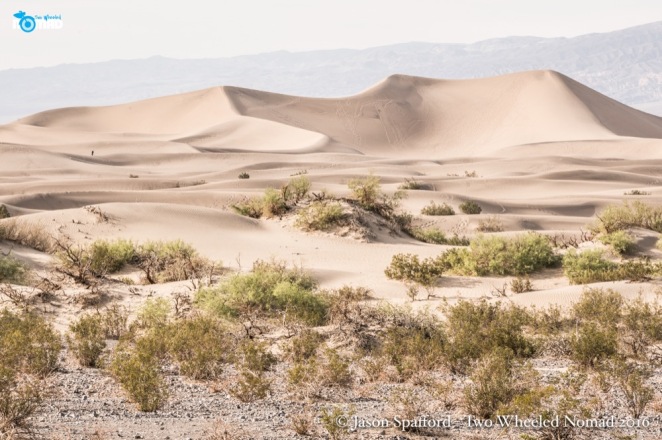
Just want to crest those dunes…so close but so far on our DV stint
With the support of our two chase trucks, the team deposited us safely back into civilization at Lone Pine where the washing machine, hot water and a fresh change of clothes became my new objects of desire. For us, the remainder of the expedition would have to wait; Death Valley had claimed Jason’s stator but at least we’d live to die another day. I guess that was the way of it: the Pearl riders roll on, the vultures keep circling and it’s imperative that venturing deep into Death Valley isn’t to be taken lightly.
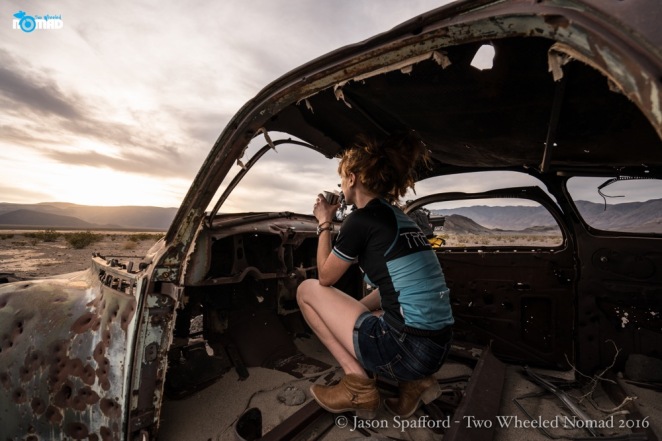
See you again, DV
